Don't wanna be here? Send us removal request.
Text
Progression of Time Crunch (Weeks 45-50)
I’m closing off 2019 on a good note! While UNKNOWN was certainly a time crunch itself, nothing will compare to the amount of effort put into the 1-day projects.
What were they?
The 1-day projects were simple projects that were given to us on the day, and we had the entirety of the college day, or about 7 hours to complete it and then showcase it to everyone else in the class! Sounds impossible, right? Well... it’s not!
Mini-project 1 - MENACE
Our starting point for this project was the 2019 Election Vote between Jeremy Corbyn and Boris Johnson. We had to create something to encourage our viewers to vote... or else!
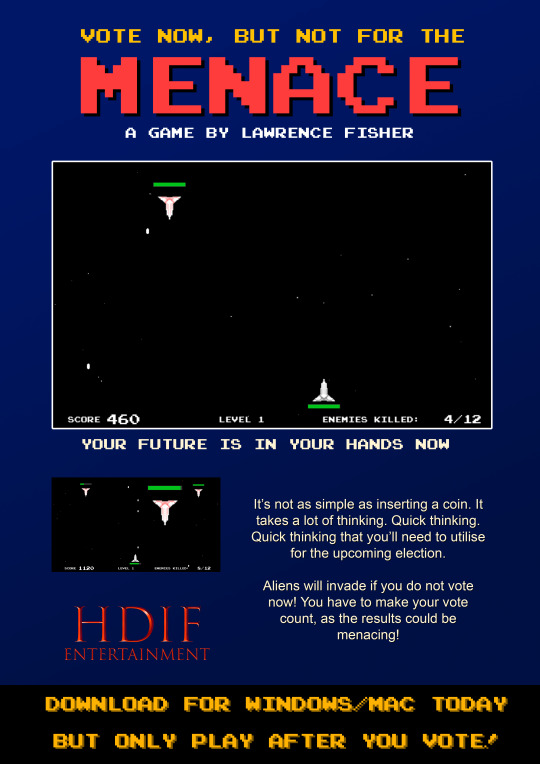
MENACE was more than a term to describe the two overlooking idiots we’d be voting for, but something to describe the consequences that you would suffer from because you brought it on yourself.
Normally, the class would work in teams to create a day project. But me, being the project-destroying challenger I am, I worked alone.
The game took about 3 hours to make, and then I made the poster (in another hour, totalling 4) with screenshots of the game (see above).
Mini-project 2 - CHANGE
Our starting point for this project was World War 3 breaking out all of the sudden with no known origin. We had to create something that would normally appear in World War 3, like a mutant or a bunker to stay in.
I, being very tight on model design, chose to do something else. Make a 2D interactive environment that would show what happened if World War 3 broke out... kind of. I went out of the boundaries and made a timeline showing what would happen if we kept on doing bad things to our planet, from destroying trees to filling our oceans with plastic.
The interactive environment was left unfinished and never got showcased, but here are the tiles I made for it so you can get a good feeling of it:


Personally, I think this is the best art I have ever created.
Anyway, the point of the tiles is that each column represents a different era. The leftmost one is the beginning of the Earth, and the rightmost one is the end of the Earth, where everything dies.
Mini-project 3 - NORTH
NORTH was... voluntary. I chose to do it. We originally did have a third day project planned, but the information needed for it was missing.
After doing CHANGE, I started work on a tile sheet.

Yep, I’m learning something new... well, I was. These would then be used in a tile map in Unity, which is how 2D games draw platforming levels as separate images build the world around it.

As soon as I learned how to make a tile map, I built part of my level. But then... the hard part came in... character design.

If you don’t know me personally, you wouldn’t know that I am a newbie at character design, especially in pixel art form. I drew four frames of an elf (idle, walking and jumping), and then moved it into Unity. I knew how to work with a sprite sheet (which is what this is), so this was easy to implement.
Doing these day projects taught me a load of things. Most importantly, it IS possible to create a good-looking project within several hours. You just need to know how to manage time perfectly and get everything organised before taking it on.
However... this game is incomplete. But since this doesn’t count as a proper project, I think I can let it stand down if I don’t finish it before the end of term. I can always finish it in my spare time if I want to, which I might end up doing.
Speaking of which, my next blog will be term6itmedia. This will be the penultimate blog for this course and will contain a pretty interesting starting point... Japan. Yup, it’s a M.A.R.S project!
0 notes
Text
Research - Games + How They Are Made
Games are a form of interactive entertainment that is played by one person or more, which can derive from many different themes, including education. Games can come in multiple different forms, such as a board game, a compact disc with the game on it (particularly on consoles, which you can learn more about in my History post) and one that is completely made up and requires nothing but a few people (like Elevenses, which many people play at once and are eliminated over time). For this post, I will be focusing on the digital side of games (which is commonly known as “video games” today), because my game will be digital-based.
Fallout
youtube
Fallout is one of the most recognisable video game series, due to it’s highly detailed map design (which you can learn more about in my Map Design post), story and how it is related to other games which I’m also going to cover in this post, including my own.
There are many Fallout games, so I’ve decided to choose the third one because it is somewhere in the middle (series like these started in the early 2000s where there wasn’t much detail and shapes in video games), which isn’t too old or too modern.
Mad Max
youtube
Mad Max is another game I’m looking at (even though I’ve never really played it, which is about 60% of the games I’m looking at on this blog) that has a story and genre similar to Fallout and my game - war, stop the source.
Unlike Fallout and my game though, this looks like a driving game, however there are segments of the game where you can walk your character around and explore the maps.
Because this game is a bit more modern, the graphics and models are more realistic when compared to older titles (like Fallout 1 or Steel Battalion (referenced in my Video Game History post)).
Metro Exodus
youtube
Metro Exodus is the third game I’m looking at in this post. Don’t worry, I’m not just going to look at games of the same nature as mine, I’m just doing these three to compare them all before I move on to something else.
Anyway, like Mad Max, Fallout and my game, it is a shooting game. You might be thinking; “Aren’t these games the same thing?”. Technically, yes, but there are differences.
Fallout is supposed to take place past the 2100s, which resembles a dystopian future similar to the film Elysium, where Earth is completely wasted and nothing is what everyone hoped it would be. Mad Max is set in the present time, but set around someone getting bullied and willing to repair their car (which had just been completely smashed to bits). Metro Exodus is also set in the future, but after a set of cataclysmic events which may or may not kill the player depending on their actions throughout gameplay.
For my game, it will be set at an unknown timeframe, mainly because I haven't specified one in the storyline.
How a game is made
This will cover some difficult technicalities that many people will not understand.
The concept
Ideas (particularly on a mind-map or list)
Further development
Learning how to code (if you’re making a digital game like Fallout or one like mine)
Create assets (or models if you’re making a board game)
Create maps
Planning behaviour of objects
Code, build, test, repeat
The Concept
Making up the concept of your game is the starting point, and quite possibly the most difficult. Coming up with something that nobody has ever done before is tricky, because it requires a lot of research and patience. Once you have your concept, you may need to develop it further if it doesn’t go into too much depth.
Ideas and Further Development
For my game, I had to start out with a Pinterest board, which comprised of many different images of fire, energy and many things that were war-based. From there, I made multiple plans of what I could have. There were many things I have ended up scrapping over this process because they were either too hard for me to make or not really necessary.
Learning How To Code
If you’re making a digital game like Fallout, this is where most of the work will be put together. Programming is the hardest part of getting something working, and you can’t learn it in a day. It will take a few weeks of preparation to make a good working script, unless you get someone else to provide you the code (you may have to pay them for it, which also brings up the question of why games need a team, which is ridiculously expensive). Once you get used to learning how to code, you will be fine from here… well, not quite.
For me, I started out on the Scratch engine 8 years ago, which I never went forward from late 2018, when I started using Game Maker Studio. Early 2019, I learned how to use Unity and code in another language entirely, which wasn’t too difficult for me due to the experience I have had in the past.
Creating Assets and Maps
Maps can be done in a number of ways:
You make the maps yourself.
Have someone else make the maps for you.
Downloading samples and editing them (don’t do that!).
For my game, my map is mostly flat, which only requires a modification at an edge of it to make mountains, which is done in Unity using paint tools on terrain. The easy thing to remember is, ALL terrain you make starts out flat, unless you’re heavily editing a shape, like a sphere.
Assets however, are a lot more complicated. First of all, you need to know how to use a 3D engine like Cinema4D, Mudbox or Maya, unless you are making a 2D game, in which case you need to learn how to draw sprite sheets or code animation. I’d suggest starting out in pixel-art form, as it is very easy to work with.
If you’re willing to go to 3D already, then you need to learn how to make basic objects, like a chair. It will then take some practice to get to high-end levels like a gun or even a full re-creation of the tallest building in the world (that’s a joke, by the way), but after that, you’re good to go with assets and map design.
Planning Behaviour of Objects
Will your planned object jump out at you if you get too close to it? Will that tiny box in the corner of your room endlessly spew out bullets? Will you plan that object’s behaviour (or AI in modern terms)?
Planning behaviour for an object can be a bit tricky if you’re not good at digital animation (like in Cinema 4D) or if you’re just really rusty at programming. However you plan it is up to you.
For my game, a turret will endlessly fire bullets in the direction it faces because of a timer in the script that triggers the bullet to appear when it hits a certain value, and a cube will endlessly spin in a reactor until it is destroyed.
Code, Build, Test, Repeat
The most difficult part of making a game is actually getting it to work. This is the longest process and requires a lot of trial and error to be finished. Indie developers work on games alone, while most games are made by a company/team who have assigned jobs individually (one will do the graphics, one will do the sounds/music, etc.).
Don’t forget, testing is important! Nobody likes a game that is full of bugs/glitches, as this makes the game completely unplayable.
0 notes
Text
Research - Game Covers
This is a post that was copied over from one of my previous blogs, term3itmedia. It has only been slightly edited to be relevant to my project today.
Game covers are the main art of the game that is meant to stand out on a case with the game inside. Game covers can also be used to promote the game, such as on other websites or on banners in the street.
Minecraft

Minecraft’s cover has many aspects of the game on it’s cover, including who made it. This will be our base cover to go off of, as not all game covers are the same (obviously, since they’re different games).
In this cover, you can the main character figure with a tamed wolf and multiple animals and enemies in the background, because the game features these said entities. The game’s logo is at the top of the cover, which is the also placement of the logo on a game cover.
I don’t have any opinions on this cover as it is rather simplistic, but the upcoming ones are not.
Bioshock Infinite
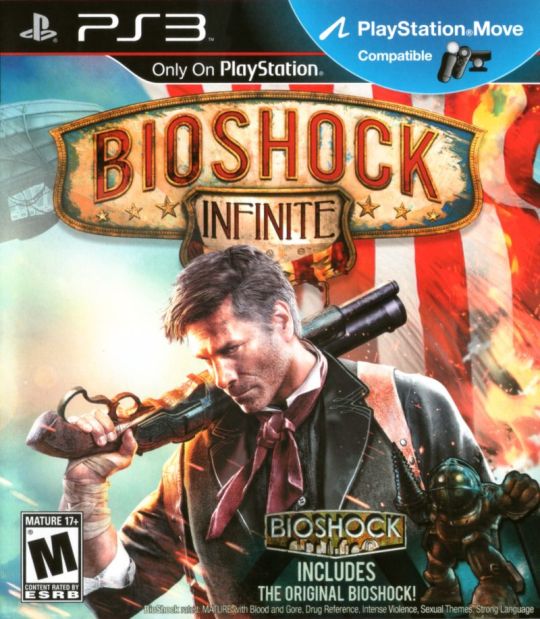
Bioshock Infinite’s cover shows a man carrying a gun on his back while trying to endure a storm of sparks, possibly from bullets. The game is all about shooting down bad guys and mutant creatures, which is why this cover the way it is.
Due to the graphical detail in this cover, I’m unsure if this is real or not. My guess is that it is not, because you shouldn’t really leave anyone in a storm of sparks in case they get badly burned, but I like this cover due to all of the detail involved.
Onto another detail on game covers, the age rating. Age ratings are shown in the bottom left corner of the cover, which tells the viewer what the age restriction is on the game (3, 7, 12, 16, 18 or E, E 10+, T, M, A (child to adult)).
Fortnite

Fortnite’s game cover shows four people standing on a high surface holding weapons to get away from zombies (look closer at the bottom of the cover to see the arms), but the person in the very middle overlaps the game’s logo, which isn’t very easily readable due to the background’s brightness (the logo is white while the sky is light blue? that’s not good colouring).
I don’t really have any opinions on this game cover, but I do like the details on the characters and weapons.
Super Mario Maker
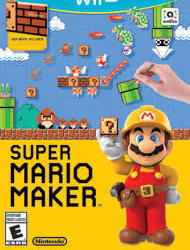
Super Mario Maker’s game cover consists of the main character of the game, Mario, wearing a builder’s outfit and holding a question mark block, symbolising “building a level”, which is what this game is all about. The top half of the cover shows a bunch of blocks and enemies spilt all over the place while a green pipe is being shifted by the player, hence the hand.
The bottom half of the cover does have a matching colour scheme, because no other colour would really work due to it being based on yellow and red, while the top half is just full of colours. Again, I don’t have any opinions on this cover, but I would say that it is alright and catches people’s eyes whenever they see it on the shelf of a game store.
Game covers are meant to be baiting eyes towards them with their art style, but doesn’t guarantee a purchase whenever they are seen as it depends on what the game is about. For example, if one finds a copy of Bioshock Infinite but enjoys making levels instead of killing people (not in real life!), then they would discard Bioshock Infinite and pick up Super Mario Maker instead.
For my game, I have made a game cover:

As you can see, the game cover captures the experience of the guy involved in the storyline, as they’re in a dark time.
Would I make another one? Maybe in another project, as I feel that one is enough for this project and most games only have one game cover.
0 notes
Text
Research - Age Rating
This is a post that was copied over from one of my previous blogs, term3itmedia. It has only been slightly edited to be relevant to my project today.
Age rating is a set restriction to the game which tells the viewer who can play it and who can’t. This is to keep younger audiences from possibly becoming a monster who goes around stealing cars from playing Grand Theft Auto, or by simply breaking everything like in Minecraft, or just stopping the child from being taught adult-related stuff.

As you can see from this picture, the rating goes from 3 to 18, with 3 being the lowest and 18 being the highest. Below it are some serious terms that are important to the viewer when being bought, otherwise they could buy a 3 rated game with bad language… which doesn’t happen. Along with the age restriction, some of the warnings apply too. For example, fear would begin at 12, and sex + drugs + gambling would be an 18. If all of the warnings apply at once… you’re in for a tough game.
The age rating complies with the law, as without it there would be a huge wild guess and a lot of scared children. If the person wanting the game is under the age of 13, they have to let their parent buy the game. If the age rating is a 12 and the person wanting it is under that age, they simply can’t have it. 18 is very rarely seen in public, with 7 and 12 being the majority in game stores.
Young Audiences
Young audiences will be able to play games that are suitable for children, with little to nothing unsuitable for that age range.
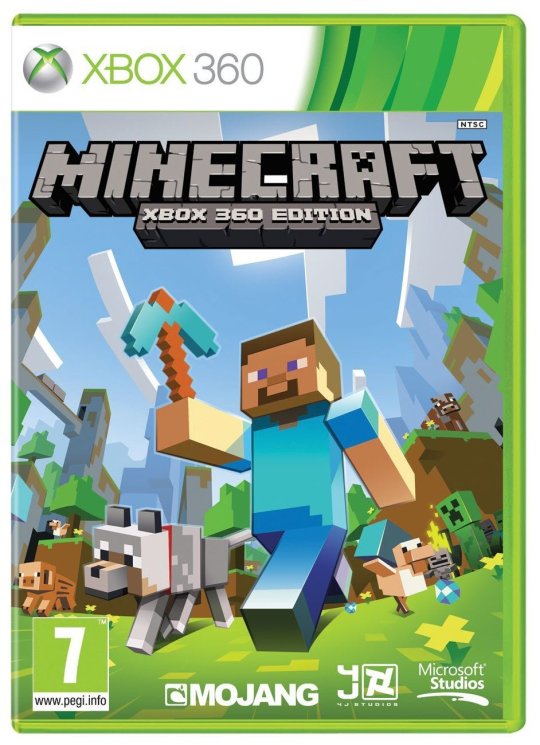
Take Minecraft for instance, which is a kids sandbox game, with an age rating of 7. This is because there is some form of violence involved, but not grim enough to be called a 12. Most modification expansion packs for the game (made by players) however, do not have an age rating… so watch what your kid downloads!
Teen Audiences

Overwatch is a 12 rated game due to the violence involved in the game and the fact that online play takes place. Online play can be done in Minecraft too, but some online servers do not have restrictions, so be careful. Unlike Minecraft, Overwatch has use of guns, which is what gives this game it’s 12 rating.

The majority of the Call of Duty franchise is rated 16 due to the strong violence that takes place with guns, bad language, online play with no filters (so a player can say the most vile words possible and not get told off for it by administrators, however there are settings to disable voice chat) and gruesome features that should be unseen by younger teenagers.
And finally…

Grand Theft Auto has an 18 age rating due to violence, bad language, drugs, gambling, discrimination, fear, sex and online play. Almost all of the warnings apply here. It may also contain explicit language, which should not be heard by players under the age of 18.
For my game, due to mild horror, I will be rating the game 12 to comply with what I’ve just described. There is no speaking in the game, but horror is a genre that isn’t really suitable for younger audiences. You can learn more about the horror genre on my Horror post.
0 notes
Text
Research - Puzzle Games
Puzzle games are games with puzzles blended into them, possibly to create more enjoyment and strategy for the game. How these games work is that the player would need to solve a puzzle to move on to the next level.
Portal + Portal 2
Portal is an iconic puzzle game, as it mostly revolves around using portals to solve puzzles, which involves cubes, turrets, pressure plates and energy balls.
(this is gameplay of the second Portal game, the first game is pretty much just a puzzle rush)
youtube
As you can see, it takes a lot of thinking and scientific knowledge to solve puzzles in Portal.
How does this relate to my game? It doesn’t. I don’t use portals or anything to do with the gravity to solve puzzles, they’re all simplistic. Maybe some time in the future, I will try and do something like this, which I know how to do.
Superliminal
Superliminal is a puzzle game that has been recently released at the time of this post, which mostly revolves around perspective to solve puzzles. How it would work is the player would pick up an object, and depending on perspective, would make the object bigger or smaller.
youtube
Looks complicated, doesn’t it? Because it is. I don’t even know how it is made, but if I had to guess, it would be to do with distance of the object you’re supposed to be looking at, like a wall. Depending on the distance between you and the wall, the object would change in size. But that’s my best guess.
Imagine having this in real life, just get a small piece of gold, enlarge it, become the world’s first trillionaire in just a few minutes!
How does this relate to my game? Again, it doesn’t. I don’t even know how to make something like this, like I said earlier on.
The Witness
The Witness is a puzzle game where the player is stranded on a random island and has to solve puzzles to both explore and escape it.
youtube
As you can see, the puzzles are mostly maze-based, which is where the player would click in the big circle and a glow would appear where the lines are supposed to lead without crashing into any of the walls nearby.
How does this relate to my game? Again, it doesn't. I haven’t quite figured out how to make something like this, but I'm still trying in my spare time. It isn’t that difficult.
Reky
Reky is a puzzle game that involves a black dot which has to move across coloured cubes to get to the end.
youtube
You can see it is quite complicated. And it is. Even the process of making a puzzle game like this is hard enough. Do I know how to make something like this? Kind of...?
How does this relate to my game? Well, I have attempted to make a cube puzzle of some sort involving falling objects, so... this kind of relates to it? I think it does, but I could be wrong on so many levels.
So now you know what puzzle games are, and what kind of puzzles there can be in a game, ranging from a tile puzzle to physical-momentum-based-defying-the-laws-of-gravity throwing around objects puzzle. Crazy, huh?
0 notes
Text
Research - The Woman in Black

The Woman in Black is a 1983 horror novel written by Susan Hill, which is about a retired solicitor named Arthur Kipps who was summoned to attend a funeral of Mrs Alice Drablow, where Kipps sees a shadowy figure, a woman in black. Eventually, he goes through a sequences of events that the Woman in Black is involved in, trying to find out information about her. All the unexplained that Kipps went through is eventually revealed, including the Woman in Black. The Woman in Black causes an accident involving a horse and carriage, killing Kipps’ fiancee, Stella.
Adaptations into other forms of media
The novel was turned into a stage play in 1987, four years after the novel’s release, which took off in 1989 in London. The novel was turned into a film which was aired on television in the same year.
youtube
In 2012, the novel was turned into another film starring Daniel Radcliffe, who you may remember as Harry Potter. This was not a remake of the 1989 film, as it has a different storyline than the novel.
In 2013, the novel got a sequel called The Woman in Black: Angel of Death, which was also turned into a movie in 2015.
Game?
No game of The Woman in Black currently exists, and it is unknown if one is going to be made. Would I be the first one to make it into a game? I would probably do it, because without even reading the book, I know I can enjoy it just by watching the trailer. I would probably have to read the book before I can make it into a game, which I have no interest in doing. As such, I won’t be making it into a game. Sorry.
0 notes
Text
The Time Machine Trailers Review
In this blog post, I’ll be reviewing the trailers for the 2002 film, The Time Machine. I’ve talked about the book in a previous post on this blog as well as on term4itmedia, but did you know about the films? Probably not.
Let’s start with it’s teaser trailer:
youtube
Teasers trailer do not show us any clips from the film, but instead entices us to go and see the film by using key words or sentence to do with the film like “0 TO 800,000 YEARS IN 1.2 SECONDS” or “FAST”, which is what a time machine is, takes you to any time period in a short amount of time.
You can also tell the film is science-fiction from the music in the background, because it is made out of something called synth-wave, which comprises of multiple synth pads and leads accompanied by bass.
Because the film is science-fiction, there is multiple special effects to show it, like the long glass bars that slide across the screen and flashing text with visuals (like the dial pointer during the “0 TO 800,000 YEARS” part).
It’s amazing how much you can learn about a film just from the teaser trailer alone without seeing any scenes from the film itself, it’s crazy!
But now, let’s look at the theatrical trailer, which shows scenes from the film itself:
youtube
Already you can see the differences, right? No? Did you even watch the teaser trailer before watching this one?
The theatrical trailer is much more revealing than the teaser trailer, because there are clips from the film shown, including ones of great significance, such as the main character using the time machine to travel ahead 800,000 years, or showing a tribe how to resist during a fight.
You can also see that at some points throughout the trailer, text pops up showing more power for the main character in the film, such as “HERO OF THE FUTURE”, which is what he goes ahead and does at the end of the trailer by saying “Wrong, I will change it”.
So now you know the differences between a teaser and theatrical trailer, as well as some details about The Time Machine, have you not seen it yet. Spoiler alert, I haven’t either.
0 notes
Text
Research - Do Androids Dream of Electric Sheep?

“Do Androids Dream of Electric Sheep?” is a science-fiction novel written by Philip K. Dick that is about a bounty hunter that is going to kill six androids, only to be caught by the police during a test, taken away to a prison the bounty hunter has never heard of. Meanwhile, the androids plan on how to encounter the bounty hunter, but fail. After the bounty hunter destroys the androids, he goes to an uninhabited area to reflect on his actions, only to find a random toad, which is secretly a robot.
Adaptations into other forms of entertainment
In 1982, the novel was turned into a film called Blade Runner, which has the same plot as killing androids, but is heavily inspired by “Do Androids Dream of Electric Sheep?”.
youtube
Game?
The original novel has no game, but there is a game of Blade Runner, which was released in 1997:
youtube
Would I make a game out of the novel? Probably, as I like the concept of humans stopping a race of androids that plan to take over the world. I don’t plan to introduce stuff like this in my final outcome as I’m mainly focusing on other mechanics which would be involved in a game inspired by the novel or Blade Runner.
0 notes
Text
Research - Shepard Tone
I do not plan to include this, I have just mentioned this in a previous blog post and thought I would share the technicalities behind it here and why I don’t plan to include it.

The Shepard Tone is a never-ending audio illusion that is made out of multiple octaves of sine waves. How it works is that these sine waves continuously rise in pitch. Every now and again, one of them drops down in pitch. Because of the other sine waves rising at the same rate and approaching the octave that the higher sine wave was at, it plays a trick on the human mind that a pitch is being listened to that is rising in pitch forever, but in reality, it is always repeating.
An example of Shepard Tone can be listened to here, which shows example of both ascending and descending:
youtube
Very clever trick, right?
While it was fit very well with my endless stairs part in my game, I won’t be including it as I’m not focusing on audio effects. Maybe I will focus on this in the future, but not for this project.
0 notes
Text
Research - Let The Right One In
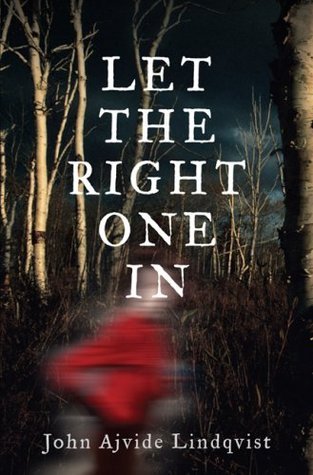
Let The Right One In is a 2004 horror novel that involves a 12-year boy named Oskar who lives with his mother. He befriends a child of the same age called Eli, who moved in next door to Oskar. Eli lives with a paedophilic father named Hakan. Little does Oskar know, Eli was a vampire that was turned into a child who was castrated during the process. Over a plethora of activities involving arrest and hospitalisation, Oskar teams up with Eli to fight back against his tormentors, but after being cornered by one of them they flee the city with Eli’s possessions, after which the story ends.
Adaptations into other forms of media
The novel was turned into a Swedish film in 2008 (subtitled English for viewing purposes):
youtube
While the Swedish film wasn’t seen anywhere else in the world, it was turned into an English version of the film in 2010, which bombed:
youtube
Game?
A game of Let The Right One In doesn’t exist yet. Would I make one? Probably not, since some of the book is quite graphic similar to The Wasp Factory (which I did a review on in a previous post). But if we cut out the graphic bits, then I probably would after some learning about model transformation.
0 notes
Text
Research - Pet Sematary

Pet Sematary is a horror novel about a graveyard of pets which is nearby a cemetery for human beings, which turns out to be an ancient burial ground, which is cursed to bring people back to life as an evil entity. A few months later, the main character, Ludlow, has his son is killed by a speeding truck. Driven with grief, Ludlow decides to bury his son regardless of the warnings from Jud, his neighbour. His son comes back to life as a demon, who murders his wife (Rachel) and Jud. At the end, Ludlow still hasn’t learned his lesson and buries his wife. Rachel then comes back to life.
Adaptations into other forms of media
The earliest known movie of Pet Sematary was released in 1989:
youtube
...but a remake was created in 2019:
youtube
Game?
The only game released for Pet Sematary is made for iOS:
youtube
Would I make a game out of Pet Sematary? Judging by the amount of gore (as interpreted by the 2019 trailer), no. Also because I currently don’t know how to model animals or make AI for them in a game. Perhaps that is something I should try in the near-future...
0 notes
Text
Progression of Translation (Weeks 38-44)
Whew! What a short timespan it has been. A timespan so short I forget how long it is, but then again, what timespan isn’t?
Jokes aside, this is my LOST in Translation project development, where I take you from how the project started to how it ended. While the end of the project may not be reached as this was a time of experimentation (much like the project on term4itmedia), it is always fun to try out new things.
Storyline
The story that the project is based on can be read here, you can also see the inspiration behind it:
https://docs.google.com/document/d/1T92xgHxDE_SK41XdTP9R8LZaY_4Ipj3GePy4YdF4DNQ/edit?usp=sharing
Our objective was to make up a concept for a game based off of books we have researched. I have chosen to focus on two key elements; combination lock and endless stairs. These were things I have never tried before but have always wanted to try at some point.
I started out the project making some planning sheets for the areas in said game should it be created, as this was a too big of a project to finish within the short span of 6 weeks.
In the middle of the five sheets is the entire storyline:

Combination Lock
A combination lock is a puzzle that can only be solved by the person who knows the key code, or someone who is extremely lucky to get it right on the first guess, which is rare depending on the amount of possible combinations, which you can learn more about in my Puzzles post.
6-digit code

I started work on a 6-digit code lock next, which if you didn’t know has 1,000,000 total combinations (from 000000 to 999999). How it works is that the player of the game would point towards a button and press it to change the value of one of the digits. When he/she thinks all six are correct, they press the button under “Submit”. If the code is right, the door opens. If the code is wrong, nothing happens.
Pretty basic, but we’re only just getting started.
Maths!
Hate Maths? Well, too bad. You have faced a problem like this before.

Before moving forward, since I’ve told you how the previous one worked, maybe you can figure this one out for yourself. Don’t read further beyond this point until you have at least tried once.
Did you get it? If not... I’m surprised you can figure out how to use a phone. Jokes aside once again, it’s very simple.
The button below the plus sign increases the value of the third number by 1 (up to 99, after which it will refuse to go any higher), the button below the minus sign decreases the value by 1 (down to 0 at minimum) and the button below the Submit button checks if the answer is correct. If the answer is correct, the door opens. If the answer is wrong, nothing happens.
This is a randomly generated mathematical problem, as the first number can have any value between 0 to 49, and the second number can have any number between 0 to 50 (so the third value will never be higher than 99).
Another way I could have done it is with symbols, like:
1: A + A + A = 15
2: B x A = 50
3: C + B + A = 22
4: (A * B) * C = ?
The player would have to figure out the answer to the 4th question, which requires a bit more challenge than a simple 2 + 2 = 4.
-- ANSWERS REVEALED IN THIS AREA --
The reason why that is is because each letter has an assigned value (A = 5, B = 10 and C = 7). Knowing all of these values, you would be able to figure out the answer to the question, which ((5 * 10) (50) * 7 = 350.
-- OK, YOU’RE SAFE NOW --
I didn’t end up doing the algebra problem in the end, but that doesn’t mean I’ll use it in another concept.
Let the ball in!

This is... not really considered a puzzle but a reflex-based mini game that you would have to play if you got any of the other puzzles wrong. What would happen is that you would give a number between 3 and 16, after which a grid of cubes will generate based on the number given, which is known as squaring using maths. Yep! I’m using maths to make this.
When the cube grid is generated, each cube has a 1-in-10,000 chance per frame to instantiate a ball far above it, which is telegraphed by it’s shadow to show it is coming. If the ball were to go through, points would be added. If you were to reach a certain amount of points (50,000 for example), you would move on to the next area. If balls were to hit the cube they were dropping towards, points would be subtracted. If the points were to go into the negatives, you would lose the game.
The bigger the grid, the faster you would have to be as the balls would spawn more frequently. In the case of a 16x16 grid, the balls would have a 1-in-40 chance of spawning per frame! Imagine trying to keep up with that!
And you thought a catching game was hard enough...
youtube
The mini game remains unfinished and I don’t have any intention of finishing it off in another project.
Rotating stones

This puzzle was by far the most complex one I have ever made. This puzzle has 8 letters on each stone, and only one word can be written out of them. There is approximately 32,767 possibilities, and only one of them is a real word. I had to painstakingly check for any letters that could create another word, and so far I have found a few, including a swear word which I removed straightaway upon seeing, because nobody wants to see that.
How the puzzle would work is that the player would point at one of the stones and click to rotate it 45 degrees, to get to the next letter. Once all of the letters are lined up, the boulder blocking the exit instantly breaks and the player can advance forward.
Endless Stairs
The endless stairs trick was easy to learn but difficult to make perfect. Like I said before, I wanted to try and make it like the one from Super Mario 64 (which you can find out about in my Infinite Stairs post).
This also gave me a chance to try out something else, Fog. I added fog to this area because it doesn’t allow you to see the top of the stairs, which is crucial for this development since you never see the top anyway.

The illusion is that you get teleported down the stairs when you hit a certain point of them, which also works backwards. How? Look at this image of the structure:

As you can see, the fog makes it more eerie-looking and less revealing, especially if you go up the stairs backwards.
I chose to put the endless stairs at the end since it is unimaginably scary to think about, and at the end of some horror films or games, the main character gets stuck in a situation they cannot get out of in any way possible, which just ends after one final call for help, which nobody is around to hear.
I was going to create a concept for the traps that would be used in this game, but time fell short and I had other mandatory things that needed doing, like printing out the sheets for my portfolio and researching (which also fell short because it was difficult to get topics relevant to this project).
You can see everything in action here:
youtube
Conclusion + Reasoning behind project
First off, let’s start with the reason behind it. I chose the five books listed in the document listed above because those were the main elements that I found interesting and wanted to transform them into something new, sort of like an amalgamation, but with originality.
I took great inspiration from The Time Machine because the main character of the story is trapped in a different time period. I took inspiration from Charlie and the Chocolate Factory plus The Wasp Factory because the main character gets trapped in a situation they cannot get out of until they either die or are rescued. I took inspiration from Dr Jekyll and Mr Hyde because of the shadowy figure in my story, which is evil. If I gained any inspiration from The Girl With The Dragon Tattoo, it would have to have been hacking related. Since there is no hacking of any sort involved in my story, this one is left out. But if I had more time on this project, I would look into the concept of hacking and maybe implement a feature like that. But due to the short time and overall focus on other elements, that was not a possibility this time.
The idea of the story is completely original, as far as I am aware, and that is what I like to do. I like to be original with my ideas instead of being a person who copies everyone’s ideas and turns them into their own thing, which people have done, including me in the past. I can’t deny that.
0 notes
Text
Research - Frankenstein

Frankenstein is a horror novel written by Mary Shelley, which is about a mad scientist called Victor Frankenstein, who has spent countless hours of work sticking together body parts from various corpses to create another human being, which comes to life. After becoming ill, Victor prepares to return to his family while grief-stricken. After losing his creation, he sets off to find it, but dies before finding out it’s location. The monster then freezes itself to death at the end of the novel.
Adaptations into other forms of entertainment
Over it’s 200+ years of life, the book had been transformed into many forms of media. The earliest known movie adaptation was released in 1931:
youtube
Game?
youtube
It was transformed into it’s first game in 1983 for the Atari 2600, and ever since then there have been many variations of Frankenstein for other console games.
Would I make a game out of this? If we cut out the body-building part, then maybe? I would have to have read the novel in order to make a good game out of it, which I haven’t done.
0 notes
Text
Research - Horror
Horror is a genre generally consisting of terrifying objects and features, like jumpscares, mythical undead creatures like zombies, murders and deadly traps that catch the viewer by surprise, making them terrified at first glance.

There is criteria that needs to be met for something to be considered horror. There may be scenes with scary music, dark scenes with unpleasant shadows (such as a person holding a hair-dryer may be shadowed as a person holding a knife dripping blood), bloody murder, subliminal messages (such as REDRUM, which is MURDER in reverse), dark sounds (such as a howling atmosphere), and all types of graphic imagery. There may be a scene at the end which ends on a terrifying note, such as a person getting trapped in a dark room full of traps that have stayed active for a while, ready to take on their victim.
While horror can be exhilarating once or twice, which is OK for the average person, it can have severe (temporary in some cases, permanent in extreme cases) effects on mental health. For example, if a person saw the Final Destination franchise, they would likely suffer from a form of anxiety so great they would refrain from doing ANYTHING, which would lead to isolation.
Luckily, this is quite rare since people can say to the scared person; “it’s just a movie/game/book, nothing like that would happen”. If you have watched a horror movie/game/book that you ultimately failed to stop watching/playing/reading because you thought it would get better as the story went on, you’re not alone. Other people have done it too.
I have watched two horror movies in the past, which are Annihilation and Super 8, one of which I made a review about which can be read up on one of my previous blogs (term1itmedia). With Super 8, I... stopped about 20 minutes away from the end, it was too scary for me.
Horror. A clear reminder that despite your best efforts, you will ultimately fail.
0 notes
Text
Industry Talks Review
On the 28th of October, I went to a talk show. While I remained totally unfocused for the majority of them because they were photographers and graphic designers, there was one talk that I can relate to from it in this review, which was Sam Read’s talk. Sam Read is a worker in the gaming industry who had developed two games. One of which didn't get a popular reception, while the other one grew so fast he had no time to change the name of due to it exploding in one night - Gang Beasts.
youtube
If you don’t know, Gang Beasts is a fighting game that can have up to 4 players at any time and the last person standing is the winner. The game began to be recognised in it’s early access stages, after which it went viral. After going viral, Sam and his team were planning on changing the name of the game, but couldn’t due to the fact that the game wouldn’t sell under that name, as everyone knew it as Gang Beasts and would either not recognise it as another title if it had it’s name changed, or call it a duplicate of the original Gang Beasts.
What I have learned from this is that collaboration can be difficult and the aspects of the game should be checked more than twice, such as the title and backstories. And even with all of those in mind, it can take a while before a game in development becomes ready for launching, to not confuse fans. This is why Gang Beasts cannot be renamed as the name before it’s launch was Gang Beasts and to change it at the moment of release would cause a lot of confusion.
0 notes
Text
Research - Fog
Fog is a cloudy mist that surrounds a small area, particularly used in the horror or adventure genres. If you have ever looked out of the window and saw nothing but white-grey clouds for hours, you have seen fog.

Fog is often used in horror films and games as it is nearly impossible to see through, giving the illusion that the person is trapped in a small area and has no way of escape.
Silent Hill
Silent Hill is a dark video game, interpreted mostly by the amount of fog that is used in it.

In this picture, you can see a character standing outside what appears to be a graveyard, which is further reinforced with the fog. In this case, the fog symbolises the dead and dread of the character for losing their loved ones.
I like how the fog gives atmosphere in this scene as it is a good choice for those who have no idea how to interpret sadness or darkness in a scenario like this.
Limbo
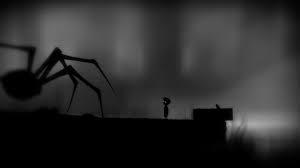
Limbo is a silhouetted video game that is usually accompanied by fog in the background and to the sides, adding an atmosphere of darkness to the game. In this case it also makes the game a bit more scary in this picture because of the giant spider to the left, which has the potential to gobble up the little boy if he doesn’t run away.
INSIDE

INSIDE is similar to Limbo, except in a 3D perspective, with fog on the horizon instead of very close to the player. In my opinion, this looks very similar to what it would be in real life.
I forgot to mention that fog is also accompanied by darkness in games like this to add a sense of horror to the experience, as anything could come jumping out of the fog at any given moment, like right now!
Did I scare you? Well, this was done two days before Halloween after all.
In my game, I plan to include fog at some point in the story. Whether or not I use it all the time is currently unknown.
0 notes
Text
Research - Puzzles
Puzzles are a complex combination of pieces that either need to be reassembled or arranged in a way that looks correct. Sometimes the puzzle can be easy, like a kid’s 50-piece jigsaw puzzle, or it can be extremely difficult to master the solution to, like a Rubik’s Cube.
Da Vinci Code

The Da Vinci Code puzzle is made of five different columns of random letters which circle around a lock, which requires the right word to be arranged (such as APPLE in this case) to be completed. It may not seem hard at first, but there is 26^5 - 1 possible combinations, or 11,881,375. If you had 1 second on each combination, it would take you 138 total days of non-stop guessing to solve it.
This kind of puzzle is called a Cryptex, which gets its name from hidden and secret messages encrypted for the sake of privacy.
And we are just getting started. Do you know the combination?
Tomb Raider

Tomb Raider has a similar puzzle type, except there are two of them, with both of them having symbols instead of letters and numbers, which require the right combination to unlock the way forward. Sadly, despite it having 9,765,624 possible combinations, it isn’t any easier to solve than the Da Vinci code, as this is a harder code to get.
Are you feeling puzzled yet? Because we’re getting to harder puzzles now!
Hellraiser
Hellraiser’s puzzle is luckily not a combination lock, instead it is a box that opens through the right finger movements on a particular side. Sounds easy, right? Well, yes but actually no, unless you watch this video.
youtube
Unlike the other puzzles, this one can be solved completely blindly, as there is an easy solution to it. So if you’re not much of a puzzle solver, you can probably solve this one easily. However, I have never tried it so you probably shouldn’t trust me.
13 Ghosts
13 Ghosts’ puzzle is... well, the whole house. The entire house is filled with cogs, wheel and complex machinery that the residents have to solve in order to enter or leave the house. I most certainly don’t want to live in that house... do you?

This entire setup is so complex I am not even going to attempt to describe it. You can just look at it and understand, it’s a lot.
Rubik’s Cube
The Rubik’s Cube is a puzzle cube that has six rotating sides, each piece has either two or three colours on it (the centre pieces don’t move so they don’t count in this case).
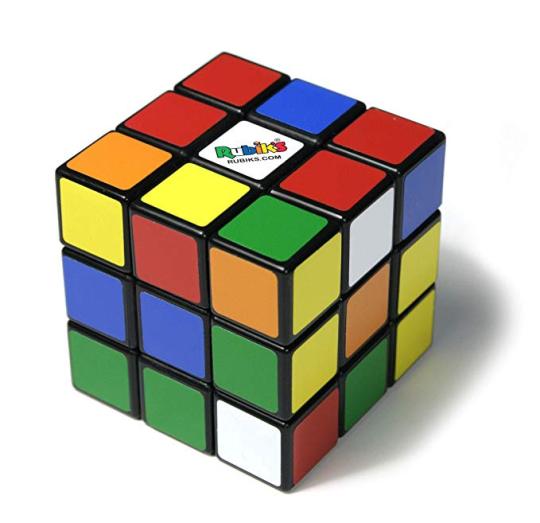
The Rubik��s Cube is quite possibly the hardest puzzle you’ll ever see or attempt to solve, as it has 43,252,003,274,489,856,000 (43.2 quintillion) different combinations. If you had that many seconds to go through each combination, it would take you over 1.3 trillion years to get through them all, which means if you had started the moment the Big Bang occurred straight through to today, you wouldn’t even be 0.000001% of the way there.
For context, somewhere between 2-5 billion years from now, the Sun would’ve finished exhausting it’s gas supply, expand into a red giant and then collapse on itself. In fact, the universe would’ve died from heat death long before you finish getting through all of the combinations of a Rubik’s cube.
Are you puzzled yet? I am... a lot.
In my game, I plan to experiment with some sorts of lock puzzles like the Da Vinci code and possibly some others which I may put on here if I have to research them. I have got some ideas from the ones listed here so I probably won’t have to.
0 notes